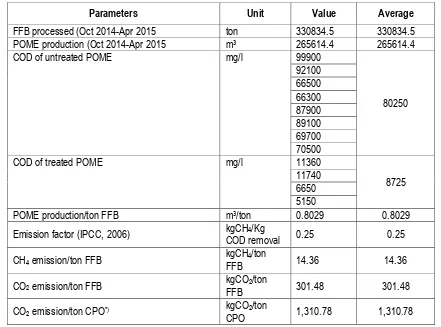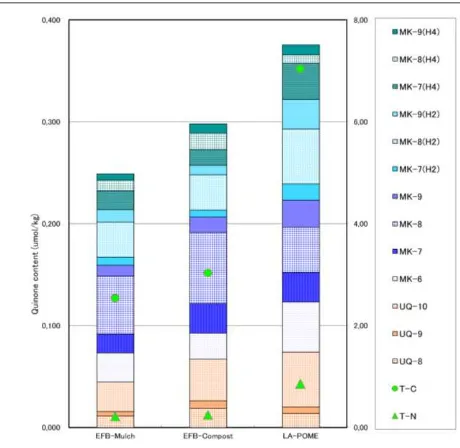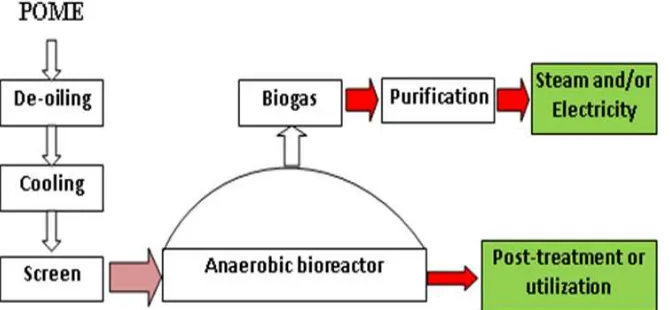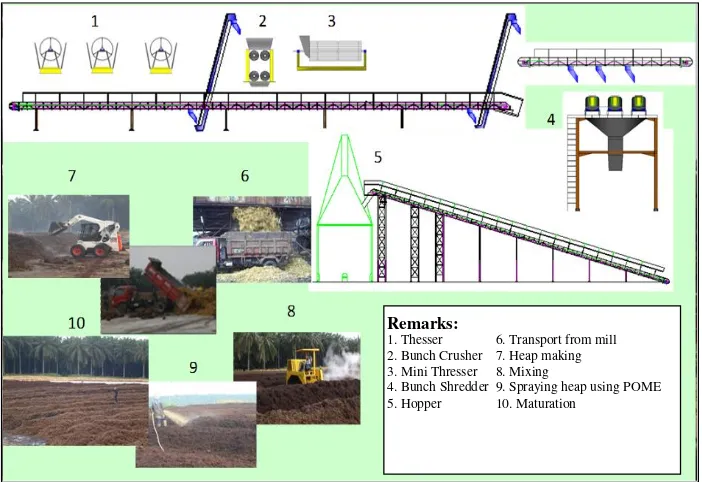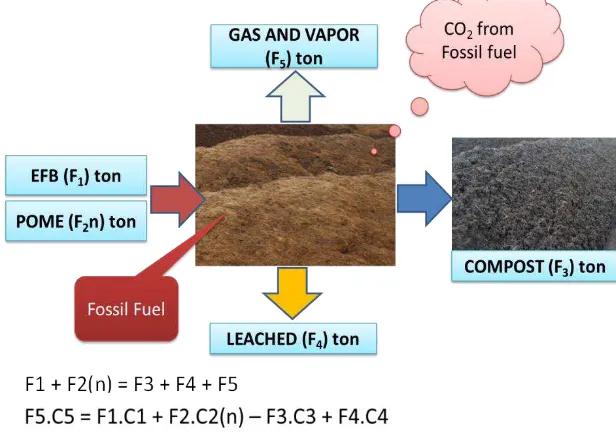PALM OIL MILL EFFLUENT RECYCLING SYSTEM FOR
SUSTAINABLE PALM OIL INDUSTRIES
Udin Hasanudin
1and Agus Haryanto
21Department of Agroindustrial Technology, Faculty of Agriculture, University of Lampung, Bandar Lampung-35145, INDONESIA
2Department of Agricultural Engineering, Faculty of Agriculture, University of Lampung, Bandar Lampung-35145, INDONESIA
Email: udinha@fp.unila.ac.id*;
ABSTRACT
Having sustainable is a key issue in the development of palm oil industries in Indonesia. Palm oil mill effluent (POME) is a largest waste from palm oil mill with very high concentration of organic matter. Several methods have been developed to treat the POME but it is rather difficult to fulfil the national effluent standard. The objective of this research is to evaluate the environmental impact of some currently implemented methods of POME treatment, such as: (1) open lagoon and land application of treated POME (as a base line), (2) methane capture and land application of treated POME, and (3) co-composting of empty fruit bunches (EFB) and POME. Green House Gases (GHG) emission reduction and renewable energy production were evaluated. Results showed that compared to open lagoon system, methane capture followed by land application of treated POME was estimated to successfully produce renewable energy about 55,3 kWh/ton of fresh fruit bunches (FFB) and GHG emission reduction about 241.2 kgCO2e/ton FFB. Utilization of treated POME as liquid fertilizer improved soil quality and increased FFB production by about 13%. Co-composting of EFB and POME was estimated to successfully reduce GHG emission about 115.9 kgCO2e/ton FFB and 191.9 kgCO2e/ton FFB for 30 and 70 days composting periods, respectively. Compost application also improved soil quality and increased FFP production about 5-10%.
Keywords: palm oil mill effluent, GHG emission, methane capture, compost
INTRODUCTION
Indonesia is the biggest Crude Palm Oil (CPO) producer with a share of about 46.6% of the world [1]. In 2013 the total CPO production in Indonesia has reached 27.64 million ton. It is projected that by 2015 and 2020 the CPO production will be 32.36 million ton in 2015 and 43.93 million ton in 2020 [2]. On the other side, it is predicted that the total world demand of palm oil was about 64.5 million ton in 2015 and increase to 95.7 million ton in 2025 [3]. This situation indicates that palm oil industries will continuously grow to fulfil the world demand. The growth of CPO production in Indonesia is about 7.8% per year; it is higher than that of Malaysia’s being only 4.2% per year [4].
Palm oil mill effluent (POME) is the biggest waste and the main source of environmental pollution
Oxygen depleting potential of POME is about 100 times more than that of domestic sewage. POME caused a major environmental problem in the palm oil industries. Without a proper POME treatment and handling, the palm oil mill becomes synonymous with POME pollution [9].
Wastewater treatment processes in palm oil industries usually use a conventional biological treatment. Generally, we can separate the processes into two types of treatment systems in palm oil industry: a) biological treatment with land application; and b) biological treatment without land application. In biological treatment with land application, the POME is treated in anaerobic ponds until BOD reaches a maximum of 5,000 mg/l, after that the treated POME is transferred the plantation as a liquid fertilizer. Now, the biological treatment with land application is a typical wastewater treatment system in palm oil industries. In Indonesia, land application systems of POME are regulated through the Ministry of Environment Decree number 28 and 29, 2003. According to this regulation, the land application system is prohibited to implement if the oil palm plantation located at: (1) peat soil area, (2) soil with permeability lower than 1,5 cm/h or higher than 15 cm/h, and (3) depth of ground water less than 2 m. The biological treatment without land application system should be implemented in palm oil industries which are not fulfilling the requirement of Decree numbers 28 and 29, 2003 by the Ministry of Environment. In this case, the effluent of POME treatment should fulfil the national effluent standard, which was regulated in Decree number 5, 2014 by the Ministry of Environment and Forestry. To satisfy the national effluent standards, the POME treatment usually consists of anaerobic ponds, facultative ponds, aerobic ponds, and sometimes uses sand bed filters environmental pollutions if it is not properly treated. In contrary, the utilization of POME can produce some valuable materials or energy which is important to
support the sustainability of palm oil industries. Sustainable POME management is crucial to developing a sustainable palm oil industry [10]. The appropriate technology of sustainable POME management for each palm oil mill is depending on the condition of the palm oil mill and plantation, such as energy supply and utilization, soil characteristic of oil palm plantations, and how much the management pays attention to greenhouse gases emission reduction initiative. The objective of this research is to evaluate the environmental impact of some current implementing method of POME treatment, such as: (1) open lagoon and land application of treated POME (as a base line), (2) methane capture and land application of treated POME, and (3) co-composting of empty fruit bunches (EFB) and POME.
MATERIALS AND METHODS
Research was conducted in two palm oil mills: one in Lampung with POME treatment using open lagoon followed by land application, and the other in Central Kalimantan with POME treatment using methane capture followed by land application and co-composting of EFB and POME. Quantity of palm oil mill effluent (POME) was observed in both mills. POME characteristic (before and after treatment) was evaluated from its concentration on COD (chemical oxygen demand) and its carbon content. Compost yield and its characteristic were observed from a composting plant. Effect of EFB compost and treated POME application in soil was evaluated by microbial existence in the soil.
Analysis
COD of POME was analyzed using closed reflux method (Hach DRB 200) followed by spectrophotometry (Hach DR/4000 U). Carbon content was analyzed using elemental analyzer (Elementar Vario EL Cube, Germany). Microbial community structure in the soil was evaluated from quinone analysis. The detail procedure of quinone analysis has been previously described [6].
Calculation
………..…(1)
Where:
CODin = COD of untreated POME; CODout = COD of treated POME; F = Volume of POME per ton of FFB; 0.25 = IPCC default value (0,25 kg CH4 per kg COD removal; 21 = Ratio of Global Warming Potential of CH4 and CO2
Greenhouse emission reduction from POME treatment ponds was estimated from COD values of influent and effluent POME. Energy potential from methane capture was calculated based on methane content of the biogas produced from covered lagoon facility. Greenhouse gas emission reduction (GHGR) resulted from co-composting of EBP and POME is calculated by using :
GHGR = E0X – (EC + EL + EF)
(2) where E0 is baseline GHG emission from POME treatment pond without methane capture, X is fraction of POME used for EBP composting (%), EC is GHG emission from composting piles, EL is GHG emission from leachate pond, and EF is GHG emission from fossil fuel used for composting operation process.
RESULTS AND DISCUSSION
Discussion will be divided base on POME treatment and utilization method. Anaerobic biological treatment in open lagoon is the most common applied to treat POME. This system relatively simple, low cost, and reliable to treat POME, but will emitted methane as one of important GHG with global warming potential
21 times of CO2. Other method was developed to reduce GHG emission including methane capture and co-composting of EFB and POME in some palm oil mill. Utilization of treated POME through land application was also adapted to prevent water environment pollution as well as utilize nutrient contained in the treated POME.
Open Lagoon and Land Application
Table 1. FFB and POME production, COD concentration, and GHG emission potential from POME treatment in open lagoon
Parameters Unit Value Average
FFB processed (Oct 2014-Apr 2015 ton 330834.5 330834.5 POME production (Oct 2014-Apr 2015 m3 265614.4 265614.4
COD of untreated POME mg/l 99900
80250 92100
66500 66300 87900 89100 69700 70500
COD of treated POME mg/l 11360
8725 11740
6650 5150
POME production/ton FFB m3/ton 0.8029 0.8029
Emission factor (IPCC, 2006) kgCH4/Kg
COD removal 0.25 0.25 CH4 emission/ton FFB kgCH4/ton
FFB 14.36 14.36
CO2 emission/ton FFB kgCO2/ton
FFB 301.48 301.48
CO2 emission/ton CPO*) kgCO2/ton
CPO 1,310.78 1,310.78
*) Assumed CPO Yield 23% of FFB
Land application of treated POME in oil palm plantation is becoming common practice after launch of the Ministry of Environment Decree number 28 and 29 at 2003. This method has dramatically reducing the potential of water pollution due to POME. Also, nutrient contain in the treated POME was utilized as organic fertilizer for oil palm and increase soil quality. Microbial quinone analysis was conducted to evaluate the impact of land application of treated POME on soil quality. Quinone profile analysis can be used as an index to characterize microorganism community [12][13] and as biomass index [13][14]. Microorganisms were known much contribute on environmental conservation due to organic matter was predominantly degraded through microbial processes in ecosystem [15][16][17]. The capacity of each an ecosystem to degrade organic matters and the
Figure 1. Impact of EFB mulch, compost, and treated POME land application on microbial quinone content, total carbon, and total nitrogen
Figure 1 indicate that land application improve the number of quinone which is indicate that the number of microorganism also improve. Total carbon and nitrogen also improve due to land application of treated POME. The treated POME land application will influence the soil health which is identified by changes of microbial community structure in soils leading to the increase of oil palm plantation productivity. Figure 1 also showed the impact of EFB mulching and EFB compost land application to the quinone content, total carbon, and total nitrogen. Treated POME land application has highest impact on quinone content, total carbon, and total nitrogen in the soil, but has not impact to the changes of quinone species.
The impact of treated POME land application was evaluated by [6]. Application of treated POME can lead to increased productivity about 13%, bunches/trees number and average weight of palm oil fruit bunches. Better soil characteristics and structure lead to improved conditions of mineralization process in the soils. Treated POME contains some essential elements providing the soils with nitrogen, phosphorus, and potassium. The application of treated POME provides nitrogen, phosphorus, and potassium which are important nutrients for oil palm growth.
Methane Capture and Treated POME Land Application
Figure 2. The objectives of methane capture of POME and their impact to reduce global and local environmental burden [9]
The utilization of POME for generating heat and electricity in a palm oil mill has increased the potential of energy produced from palm oil mill biomass waste. Figure 3 showed the process design of anaerobic treatment and utilization of POME. Through the anaerobic digestion, a biogas plant reduced the COD load by about 90%. Based on the data in Table 1 with 80% efficiency, palm oil mill with a capacity of 45 ton FFB/hour with operation 20 hour/day will produce electricity about 49.78 MWh/day or 2.07 MWe power plant capacities from POME treatment. In addition, the biogas utilization for energy also will reduce GHGs emission by about 10.34 ton of CH4/day, which is
equivalent to about 217.07 ton of CO2e/day or reduce about 78%.
Effluent from biogas reactor is suitable for land application similar with treated POME from anaerobic lagoon. POME reduction and recycling through methane capturing and land application of treated POME will not only reduce the environmental impact of POME significantly, but also will produce some valuable products, increase energy efficiency, maximize renewable energy utilization, and reduce GHGs emission. The fast growth of palm oil industries also has a high potential to give some additional revenue and other intangible benefits from POME [9].
Co-Composting of EFB and POME
Remarks:
1. Thesser 6. Transport from mill 2. Bunch Crusher 7. Heap making 3. Mini Thresser 8. Mixing
4. Bunch Shredder 9. Spraying heap using POME 5. Hopper 10. Maturation
Figure 4. Diagram of EFB-POME compost production process
The current common practice in palm oil industries are utilize EFB for mulching and treated POME as a liquid fertilizer through land application system. Some other industries are using the EFB and POME together to produce compost. Composting of EFB together with POME can minimize of nutrient losses and concentrate all nutrients from POME and EFB into one product. Figure 4 showed the procedure of compost production. Using co-composting of EFB and POME, almost all (depend on how much POME is produced per ton FFB) of POME was used to keep the moisture around 60% during the composting process [20]. A case study at an EFB-POME co-composting plant shows that about 0.347 m3 of wastewater/ton of FFB or about 43.18% of POME was utilized during 30 days composting process and about 0.627 m3 of wastewater/ton of FFB or about 78.04% of POME was utilized during 70 days composting process.
Composting is a controlled biological process which converts biodegradable solid organic matter into a
Figure 5. Material and carbon balance in co-composting of EFB and POME Using the materials balance in Figure 2 was estimated
that GHG emission during 30 days composting process is about 13.98 kg CO2/ton FFB from EFB pile and 0.3 kg CO2/ton FFB from fossil fuel consumption. Similar method was implemented for estimation of GHG emission during 70 days composting process. GHG emission during 70 days composting process is about 42.72 kg CO2/ton FFB from EFB pile and 0.7 kg CO2/ton FFB from fossil fuel consumption. GHG emission reduction was estimated using equation 2 and found that GHG emission decrease from 301.48 kg CO2/ton FFB to 185.59 kg CO2/ton FFB or decrease about 38.44% and from 301.48 kg CO2/ton FFB to 109.62 kg CO2/ton FFB or decrease about 63.64% for 30 and 70 days composting process. In other word, co-composting of EFB and POME was estimated to successfully reduced GHG emission about 115.9 kgCO2e/ton FFB and 191.9 kgCO2e/ton FFB for 30 and 70 days composting, respectively. Application of EFB compost increased number of microorganism in the soil which is described in Figure 1 and increase FFB production about 5-10% [22]. Co-composting of EFB and POME has successfully to
reduce GHG emission, improve soil quality, increase FFB production, but has not potential to produce renewable energy.
CONCLUSION
POME treatment and utilization in open lagoon system has potential to emitted high amount of GHG. Implementing of methane capture system has not only successfully to reduce GHG emission, but also produce renewable energy, improve soil quality, and FFB production. Co-composting method has also potential to reduce GHG emission, improve soil quality and FFB production, but has not potential to produce renewable energy.
ACKNOWLEDGEMENT
REFERENCES
[1] Widjaya FO, Bangun D, and Sinaga SM. 2013. Peluang dan Tantangan Industri Minyak sawit Indonesia (Opportunities and Challenges of
Indonesia’s Palm Oil Industries). Palm Oil
Industry Development Conference (In Bahasa Indonesia), Grand Melia Hotel-Jakarta, 16-17 October 2013.
[2] GAPKI (Gabungan Pengusaha Kelapa Sawit Indonesia). 2014. Industri Minyak Sawit Indonesia Menuju 100 Tahun NKRI (Indonesia’s Crude Palm Oil Industries towards 100 Years of The United Nation of The
expansion of Indonesian economic development, Coordinator Ministry for Economic Republic of Indonesia. Jakarta. [5] Saidu M, Yuzir A, Salim MR, Salmiati, Azman
S, and Abdullah N. 2013. Influence of palm oil mill effluent as inoculum on anaerobic digestion of cattle manure for biogas production. Bioresource Technology 141:174– 176.
[6] Amelia JR, Suprihatin S, Indrasti NS, Hasanudin U, Murakami R, and Fujie K. 2017. Effects of Treated Palm Oil Mill Effluent Application on the Soil Microbial Community Structure and Oil Palm Plantation Productivity. Journal of Water and Environment Technology 15(3):77-85.
[7] Mohammad AW, Yeong WT, Md Jahim J, and Anuar N. 2008. Palm Oil Mill Effluent (POME) treatment and bio-resource recovery using ultrafiltration membrane: effect of pressure one membrane fouling. Biochemical Engineering Journal 35:9-17.
[8] Setiadi T, Husaini, and Djajadiningrat A. 1996. Palm oil mill effluent treatment by anaerobic baffled reactors: recycle effects and biokinetic parameters. Water Science and Technology 34(11):59–66.
[9] Hasanudin U and Setiadi T. 2016. Sustainable Wastewater Management in Palm Oil Mill. In Green Technologies for Sustainable Water Management, American Society of Civil Engineers pp. 955-973. Reston, Virginia, USA.
[10] MPOB. 2013. Sustainable palm oil, available at http://www.palmoilworld.org/
sustainability.html. (Accessed on October 2013).
[11] IPCC. 2006. 2006 IPCC Guidelines for National Greenhouse Gas Inventories, Prepared by the National Greenhouse Gas Inventories Programme, Eggleston HS, Buendia L, Miwa K, Ngara T and Tanabe K (eds). Published: IGES, Japan.
[12] Hiraishi A. 1999. Isoprenoid quinones as biomarkers of microbial populations in the environment. J. Biosci. Bioeng. 88:449–460. [13] Hu HY, Lim BR, Goto N, and Fujie K. 2001.
Analytical precision and repeatability of respiratory quinones for quantitative study of microbial community structure in environmental samples. J. Microbiol. Meth. 47:17–24. [14] Hiraishi A. 1988. Respiratory quinone profiles
as a tools for identifying different bacterial populations in activated sludge. J. Gen. Appl. Microbiol. 34:39–56.
[15] Baker KH and Herson DS. 1994. Microbiology and Biodegradation. In. Baker, K. H. and Herson. D. S (eds). Bioremediation. McGraw-Hill Inc. pp. 9-60. New York.
[16] Fujie K, Hu HY, Tanaka H, Urano K, Saitou K, and Katayama A. 1998. Analysis of respiratory quinone profile in soil for characterization of microbiota. Soil Sci. Plant Nutr. 44:393-404. [17] Katayama A, Hu HY, Nozawa M, Yamakawa
H, and Fujie K. 1998. Long-term changes in microbial community structure in soils subjected to different fertilizing practices revealed by quinone profile analysis. Soil. Sci. Plant Nutrision 4:559-569.
[18] Hu HY, Fujie K, Nakagome H, Urano K, and Katayama A. 1999. Quantitative analyses of the change in microbial diversity in a bioreactor for wastewater treatment based on respiratory quinones. Wat. Res. 33: 3263-3270.
[19] Hasanudin U, Fujita M, Kunihiro T, Fujie K, and Suzuki T. 2004. The effect of clam (Tapes philippinarum) on changes in microbial community structure in mesocosm of tidal flat sediment, based on quinone profile. J. Eco. Eng. 22:185-196.
Sustainability of Palm Oil Industries. J. Water Science and Technology 72(7):1089-1095. [21] Diaz MJ, Madejon E, Lopez F, Lopez R, and
Cabrera F. 2002. Optimization of the rate vinasse/grape marc for co-composting process. Process Biochem. 37:1143–1150. [22]
https://sawitindonesia.com/rubrikasi- majalah/profil-produk/em4-tingkatkan-20-produksi-sawit/, accessed at 12 October 2017.
[23] Arifin, I., Awang, M.I., Tajudin, A.R.M., Norizan, M.S. and Hamzah, S. () The Effect of Compost Application on Mature Oil Palm in Apek Series Soil. Malaysia Soil Science Seminar, Bukit Gambang Resort, Kuantan. [24] Corley, R.H.V. and Tinker, P.B. (2003). The Oil
